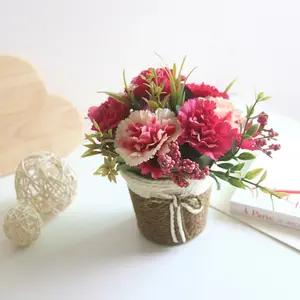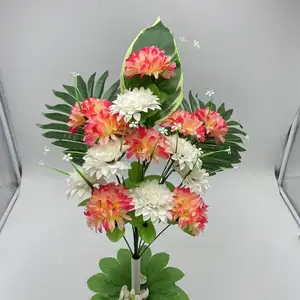Introduction
Carnations, with their vibrant colors and rich history, have been a symbol of love and devotion for centuries. These versatile flowers, known scientifically as Dianthus, are not only a popular choice for expressing various sentiments but also a delightful addition to any garden. This article serves as your ultimate guide to growing carnations, from understanding their historical significance to learning about the different types, choosing the right location, preparing the soil, planting, and caring for them. We'll also delve into pest and disease management, and how to harvest and use these beautiful blooms. Whether you're a seasoned gardener or a beginner, this guide will equip you with the knowledge to cultivate and enjoy these stunning flowers in your own garden.
Understanding Carnations: History and Significance
Carnations, also known as dianthus, have a rich history dating back to ancient civilizations. In ancient Rome, they were a symbol of love. The flower’s scientific name, Dianthus, is derived from the Greek words “dios,” meaning god, and “anthos,” meaning flower, reflecting the belief that carnations were sacred. During the Middle Ages, carnations were popular in Europe and used in herbal medicine. Today, their versatility and wide range of colors make them a popular choice for expressing various sentiments.
Types of Carnations
Carnations, belonging to the Dianthus genus, are widely cultivated for their beautiful, long-lasting flowers. There are hundreds of different cultivars, hybrids, and types of carnations. Some popular types include Dianthus barbatus (Sweet William), Dianthus caryophyllus (Carnation), Dianthus deltoides (Maiden Pink), and Dianthus gratianopolitanus (Cheddar Pink). Each type has unique features, colors, and fragrances, making them suitable for various garden settings and floral arrangements.
Standard Carnations
Standard Carnations are a popular variety known for their large, single flowers on each stem. They are cultivated extensively due to their suitability for large-scale production. These carnations are favored for their excellent keeping quality and ability to withstand long-distance transport, making them a top choice for farmers. They are in high demand for occasions like Valentine’s Day, Easter, Mother’s Day, and Christmas. They can be grown in various climates, making them a versatile choice for cultivation.
Miniature Carnations
Miniature carnations, also known as spray carnations, are a popular choice for gardens. Unlike large flowered carnations that have one big bloom on a stem, spray carnations have many smaller blooms per stem. They grow to be 9 to 12 inches high, making them ideal for smaller spaces or containers. These versatile plants are usually the ones found in a garden due to their vibrant colors and compact size.
Dwarf Carnations
Dwarf carnations are a popular variety of carnations, often found in gardens. Unlike large flowered carnations, which have one large bloom on a stem and can grow to be 18 to 24 inches high, dwarf carnations have many smaller blooms per stem and grow to be 9 to 12 inches high. Their compact size makes them an excellent choice for container gardening or smaller garden spaces. Despite their smaller stature, they still offer the vibrant colors and delightful fragrance that carnations are known for.
Choosing the Right Location for Your Carnations
Carnations thrive in areas that receive four to six hours of sunlight daily, as they prefer sunlight over shade. When deciding on their placement, consider these factors. Carnations grow best in temperatures that range from 50-65 degrees during the day and 40-50 degrees at night. Therefore, choosing the right location for your carnations is crucial for their growth and blooming.
Soil Preparation for Carnations
Carnations thrive in a full sun spot in well-drained soil, enriched with compost. To prepare the site for planting, mix a little compost and organic all-purpose plant food & soil improver through the original soil. Use a garden shovel to turn it through the top 10cm. Dig a hole twice as wide as the original nursery pot and the same depth. After planting, water well and mulish to suppress weeds and retain moisture. For potted carnations, use a premium potting mix.
Planting Carnations: Step-by-Step Guide
Carnations should be planted in an area that gets four to six hours of sunlight per day in well-drained, fertile, slightly alkalized soil (pH 6.7-6.9). Plant carnation seeds an eighth of an inch deep, spread at least 12 inches apart. Avoid overwatering, especially in the beginning stages. Light watering should be done two to three times a week. The seeds will begin to germinate in two to three weeks. Alternatively, carnations can be grown from cuttings, particularly from terminal flowers. These cuttings should be 4 to 6 inches long and inserted into pure sand. They’ll be ready for transplantation in 25 to 30 days.
Caring for Your Carnations
Caring for carnations involves several steps. Watering should be done using drip irrigation, microsprinklers, or soaker hoses to prevent leaf and flower diseases. Carnations need feeding with organic matter and slow-release plant fertilizer. Staking is necessary as the flowers can be too heavy for the stems. Pruning should be done a month after planting, leaving five pairs of leaves on the stem. After flowering, remove spent blooms to prevent disease. For perennial dianthus, light shearing after flowers fade can encourage a second round of blooms.
Watering
Carnations are vibrant and fragrant, but they can be delicate and require careful watering. Overwatering can lead to yellowing or rotting flowers. These plants need minimal water, so it's crucial to check the soil's moistness before watering. If you're caring for cut carnations, place them in a vase of clean water mixed with additives like sugar. Proper watering can result in beautiful, long-lasting blooms.
Fertilizing
Carnations, while not heavy feeders, benefit from fertilization. Choose fertilizers with lower nitrogen levels, such as NPK ratios of 5-10-5 or 5-10-10. Slow-release fertilizers are ideal as they won't overpower the plant. Liquid fertilizer can also be used in small diluted doses. Apply a slow-release fertilizer every three to four months during the growing season, or if using liquid fertilizer, apply diluted doses once every month or two. Over-fertilization can harm carnations, so it's crucial to apply correctly.
Pruning
Carnations, though requiring minimal care, benefit from pruning and deadheading. Pruning twice a year removes faded flowers and stems, stimulating a second round of blooms. Deadheading throughout the year keeps the plants looking good and encourages new flower buds. Ensure to use clean, sharp tools to prevent disease spread and make clean cuts. Cut back carnations once after the first round of flowers and again at the end of the growing season to prepare for winter dormancy.
Pest and Disease Management
Preventing and controlling plant diseases is key to growing healthy plants like carnations. Diseases can be classified as abiotic or non-infectious, caused by external conditions, and biotic or infectious, caused by living organisms or plant pathogens. Accurate and quick diagnosis of plant health is crucial to address any issues before losing the plant. Disease control requires correct identification and knowledge of the cause and life cycle of the disease. Regular and proper scouting techniques allow you to note significant changes and symptom development early enough to keep diseases at bay.
Harvesting and Using Carnations
Harvesting carnations should be done just after the flowers start to open. Cut at the bottom of the stem and condition in the usual way. Any flowers not used for bouquets should be deadheaded, allowing the plant to focus its energy on producing a second round of flowers. Carnations are known for their longevity in the vase, often lasting 7-10 days or longer. They are not only beautiful but also edible, making them a versatile addition to salads, desserts, and drinks. However, remember to remove the petals from the flower base as it can be bitter.
Conclusion
Growing carnations can be a rewarding experience, offering not only aesthetic pleasure but also a sense of accomplishment. Understanding the history and types of carnations, choosing the right location, preparing the soil, and following the step-by-step guide to planting and caring for them, can lead to a thriving garden of these beautiful flowers. Remember, pest and disease management is crucial to maintain the health of your plants. Finally, harvesting and using carnations can be a joy in itself, with their longevity in the vase and versatility in culinary uses. Whether you're growing standard, miniature, or dwarf carnations, the vibrant colors and delightful fragrance of these flowers can revitalize your garden and bring joy to your life.






























 浙公网安备 33010002000092号
浙公网安备 33010002000092号 浙B2-20120091-4
浙B2-20120091-4